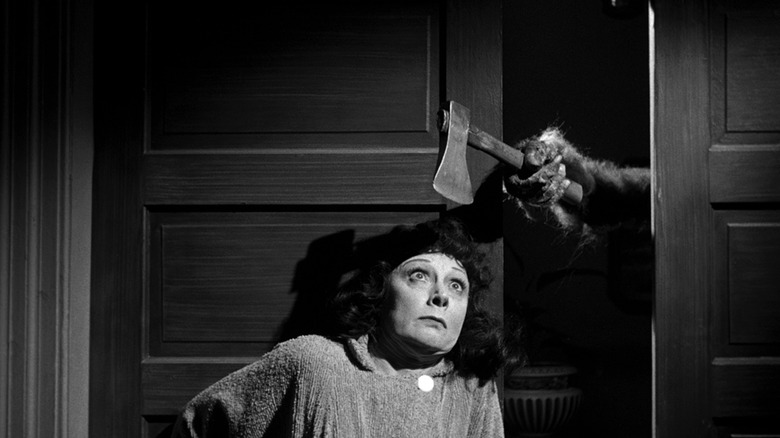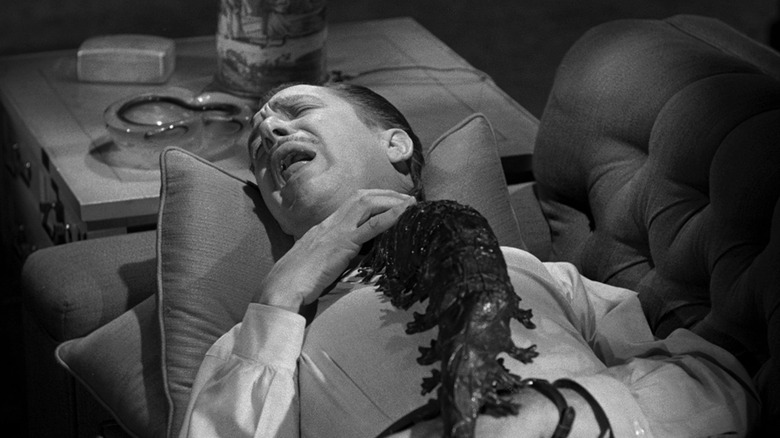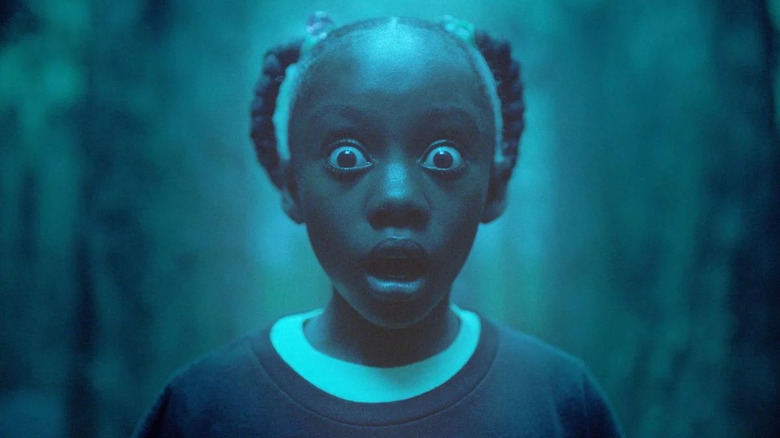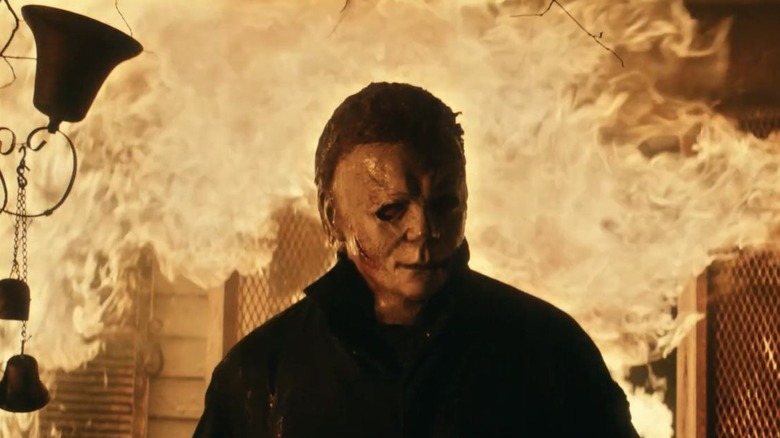Scream For Your Lives! In Praise Of The Communal Nature Of Horror
The 1958 film "Macabre" was, in actuality, William Castle's 40th film as a director, but it might be the first that could be considered "a William Castle picture." Prior to "Macabre," Castle was a studio workman, churning out multiple low-budget genre films every year, including Westerns (he made four of the eight films in the popular "Whistler" film series), gangster flicks, and medieval adventures. "Macabre" was the first film he financed himself (he had to mortgage his house), and Castle finally permitted himself to lean into the kinds of movies he always wanted to make: joyously ghoulish horror films. "Macabre," perhaps described as a more sensationalist version of Henri-George Clouzot's 1955 psychological thriller "Les Diaboliques," was a fine thrill ride unto itself, but Castle felt he needed an extra marketing ploy to bring people into the theater. His innovation was brilliant: "Macabre" was so scary, that every member of the audience was issued a $1,000 life insurance policy, backed by Lloyd's of London, in the event they should die of fright during the movie. In order to check on viewers' health, Castle also hired actresses to play nurses, and stationed them at every theater playing "Macabre."
The gimmick worked, and "Macabre" was an enormous hit. Castle immediately went to work on additional horror films, each with their own unique gimmick. 1959's "The House on Haunted Hill" was presented in "Emergo," which was simply a stunt in which a human skeleton, dangling from a ceiling-high cable, was hoisted over the audience's heads.
That same year would see "The Tingler," handily one of the best horror movies ever made (yes, seriously), presented in "Percepto," actually a series of vibrating buzzers placed underneath random theater seats. When the titular monster (a small, silly-looking centipede-like creature) grabbed an on-screen victim, certain viewers would feel it on their butts. "The Tingler" also employed actors to scream at timed moments, and additional nurses to enter the theater and bring them to safety. The conceit of "The Tingler" was that a living creature would rapidly grow on the human spine when its host is scared, and wither away when is host screamed. Screaming scares off the fear monster in your body. Late in the film, one of the creatures is set loose in a movie theater, making for a wonderfully scary metaphysical experience. Several times throughout "The Tingler," Vincent Price would address the audience directly, imploring them to scream! Scream for your lives!
Scream for your lives!
"The Tingler" is not just an excellent horror movie, but stresses something vital about cinema: it is a shared experience. Yes, one can watch "The Tingler" at home (it's on Roku, Fubo, Tubi, Redbox, Popcornflix, Pluto TV, Indieflix, Plex, and Flixfling), but it will take a little jump of imagination to picture yourself in a theater, surrounded by rowdy horror fans, each one hoping that they will be the one to be sitting on the buttocks buzzer. William Castle — the greatest American showman since P.T. Barnum — understood innately that films were a communal experience, and, with his gimmicks, brought audiences together. This was the man who invited people to look through Illusion-O ghost viewers for "13 Ghosts," or have the audience participate in a Punishment Poll, choosing whether or not the title character of "Mr. Sardonicus" should face comeuppance. An ambitious theatergoer can picture sitting in a crowd, the people around them hooting and throwing popcorn, expressing their bloodlust out loud for all the room to hear.
Movie theaters are currently facing a crisis. Every few months, another story breaks of a notable venue or theater chain shuttering, largely thanks to Covid striking right when theaters were fighting against the rise of streaming entertainment options. And while supra-mega-blockbusters are still being released to enormous numbers, the secondary-earners of the week are gaining less and less traction. It's no wonder Hollywood is pouring so many resources into tentpoles; they're practically the only thing left bringing people into theaters. Prognosticators have surmised that indie films and smaller release windows are muscling all other options out of the nation's remaining screens. Variety and mid-budget films be damned. Scorsese wrote eloquently on the matter.
Filmmakers often tout the importance of the theatrical experience. The makers of "Lightyear," Edgar Wright, and Steven Spielberg have all weighed in on the matter. And, tapping into the spirit of William Castle, both Jordan Peele and Jamie Lee Curtis, at Cinemacon 2022, argued that horror films are the most important when it comes to illustrating the importance of the theatrical experience. Horror is about thrills, being scared, screaming for your life. Said Peele, "Roller coasters aren't fun alone. Laughing isn't fun alone. Being scared isn't fun alone."
Being scared isn't fun alone
"We come to this place for magic," Peele said, continuing:
"We come to AMC Theaters to laugh, to cry, to care. Because we need that. All of us. That indescribable feeling we get when the lights begin to dim, and we go somewhere we've never been before. No just entertained, but somehow reborn. Together. Dazzling images on a huge silver screen. Sound that I can feel. Somehow, heartbreak feels good in a place like this. Our heroes feel like the best part of us, and stories feel perfect and powerful. Because here ... they are."
So goes the much-ballyhooed and widely razzed 2021 commercial for AMC theaters, a gloriously overblown poem to the theatrical experience read by AMC regular Nicole Kidman. In the ad, Kidman is seen in an empty theater (a sign of grim things?) moved to a near-spiritual ecstasy by footage from Patty Jenkins' film "Wonder Woman." It's a silly ad, yes, but lovers of the theatrical experience may understand what Kidman is getting at: There is something experienced in theaters that cannot be had at home. The sacred darkened space where films are projected allows us to more closely connect with a wider community of theatergoers.
And that connection doesn't manifest itself in vainglorious Kidmanesque smirks, but in screams, hoots, and spontaneous expressions of fear. A fun, wicked scary movie pleases us twice. Once when we scream at a jump scare, and again when we laugh off the tension immediately after. Both offer release. The first, when we face our fears in the harmless environ of fiction, and again when we chuckle at ourselves, and at others, for getting rattled.
The thrill of being afraid
Yes, other genres can provide shared thrills; I, to, was in a theater on opening night for the 2021 blockbuster "Spider-Man: No Way Home," also a Castle-like gimmick film wherein characters from five movies, stretching back to 2002, interacted for the first time. The filmmakers were careful to include long pauses in the film's action to accommodate people cheering in the theater, which — anecdotally — they did. And loudly. But that sort of shared enthusiasm, while certainly providing a party-like atmosphere in a theater, isn't quite the same as screaming. The thrill of seeing three Spider-Men is predicated on the shock of recognition and the exploitation of nostalgia. Horror provides a more emotionally honest, visceral response beyond mere thrill. Fear. Pain. Death. With horror we are facing the things we ordinarily turn away from. And, in sharing them with a crowd, find we have more in common with each other.
Attending horror in groups is, one might even argue, a form of therapy. Horror films, however wicked, bloody, cynical, cheap, exploitative, or lascivious, are, at their core, handling everyday human fears of death, pain, and blood. In watching those things in a theater, and understanding what terrifies us as a whole, we are more closely facing our fears safely in each other's arms, so to speak. Are you afraid of needles? Watch this scene from "Audition." It's uncomfortable, but at least you know it's fictional. Are you afraid of dogs? Have you watched "Cujo?" Are you afraid that your upper-class neighborhood might be secretly having incestuous shunting orgies behind your back? May I point you to Brian Yuzna's 1989 film "Society?"
But, even more basically than that, there is a very basic truth about horror, and this is where William Castle had so much keen insight: Being scared is fun. It's fun to watch monsters in the dark. It's sexy to cling onto a date in abject terror. It's enjoyable to watch other squirm in their seats, only to find that you too are squirming. It's thrilling to get that adrenaline rush that a good, startling horror movie can provide.
We're not just screaming for our lives. We're screaming to feel alive.



